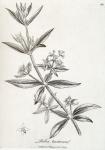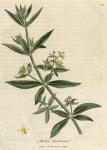
 Synonyma. Rubia. Pharm. Lond. & Edinb.
Synonyma. Rubia. Pharm. Lond. & Edinb.
α Rubia sylvestris aspera.
β Rubia tinctorum sativa. Bauh. Pin. p. 333.
Rubia tinctorum. Gerard. Emac. p. 1118.
Rubia major sativa. Park. Theat. p. 274.
Rubia sylvestris monspessulana major. J. Bauh. Hist. vol. in. p. 715.
Rubia tinctorum. Raii. Hist. p. 480. Vide Hall. Stirp. Helv. n. 708.
Rubia foliis senis. Miller's Dict.
(greek) vel (greek) Graecorum.
Class Class Tetrandria. Ord. Monogynia. Lin. Gen. Plant. 127.
Ess. Gen. Ch. Cor. 1-petala, campanulata. Baccae 2, monospermae.
Spec. Char. R. foliis annuis, caule aculeate. Mant. 330.
The root is perennial, long, round, jointed, beset with small fibres, externally of a bright red colour, but towards the center yellowish: the stalks are quadrangular, slender, procumbent, jointed, four or five feet in length, and covered with rough short points, by which they adhere to the neighbouring plants for support: the leaves are elliptical, pointed, rough, ciliated, and are placed in whorls of four, five, or six together at the joints of the stem: the branches stand in pairs at the articulations of the stalk, and upon their various subdivisions produce small terminal flowers of a yellow colour: the calyx is divided at the mouth into four teeth: the corolla is small, bell-shaped, and cut at the extremity into four oval segments: the filaments are four, short, and support simple erect anthers: the germen is double, and placed below the corolla: the style is slender, and at the top divides into two globular stigmata: the fruit consists of two round berries, each containing an oval seed, with a cavity at its smaller extremity. It is a native of the South of Europe, and flowers in June.
Madder is frequently mentioned by the Greek writers, who employed its roots with the same medicinal intentions for which they now are recommended by most of the modern writers on the Materia Medica. Our knowledge of the first cultivation of this plant in England is from Gerard; [Vide Hort. Kew.] and though an extensive cultivation of Madder in Britain seems to promise considerable advantage both to the planter and to the nation, yet we find that the great quantity of Madder roots used here by the Diers and Callico-printers, has been for many years almost wholly the growth and export of Holland. [Miller Dict. in which is also given a full account of the cultivation of this plant. But we are happy to observe, that by the laudable endeavours of the Society for the Encouragement of Arts, &c. considerable quantities of English Madder have been produced, and found as good at least, if not better than any imported. See Transactions, p. 10. vol. i.] Madder appears to differ from other substances used for the purpose of dying, in having the peculiar property [Some other plants of the same natural order (Stellata) have also the effect of tinging the bones, as the Galium Mollugo and Aparine. Vide Guettard Mem. de l'Ac. de Sc. a. 1746 & 1747. And the Valantia cruciata. Böhmer Diss. de rad. rub. tinct. p. 42.] of tinging with a florid red colour not only the milk, urine, &c. [Böhmer also found the serum of the blood reddened by the Madder. Diss. rad. rub. tinct. &c. p. 13. And Levret observes, that it sometimes tinged the excretion by the skin. Sur les Accouchemens, p. 278.] but even the bones of those animals which have fed upon it; a circumstance which was first noticed by Antonius Mizaldus, [Memorab. ut. ac jucunda Cent. 7. Aph. 91. Lutet. 1566.] but not known in England till Mr. Belchier published an account of a pig and a cock, whose bones became red by eating Madder mixed with their food; [Phil. Trans. vol. 39. p. 287. & p. 299. See also vol. 41. Afterwards experiments were prosecuted by Bazanus, Geoffroy, Du Hamel, Fougeroux, Bergius, and others.] since that time various experiments relating to this subject have been made, from which it appears that the colouring-matter of Madder affects the bones in a very short time, and that the most solid, or hardest, part of the bones first receives the red colour, which gradually extends, ab externo, through the whole osseous substance, while the animal continues to take the Madder; and if this root be alternately intermitted and employed for a sufficient length of time, and at proper intervals, the bones are found to be coloured in a correspondent number of concentric circles. According to Lewis, "the roots of Madder have a bitterish somewhat austere taste, and a slight smell not of the agreeable kind. They impart to water a dark red tincture, to rectified spirit, and to distilled oils, a bright red; both the watery and spirituous tinctures taste strongly of the Madder." [Mat. Med. p. 546.]
Madder, by medicinal writers, has been considered as a deobstruent, detergent, and diuretic, and is chiefly used in the jaundice, dropsy, and other diseases supposed to proceed from visceral obstructions, particularly those of the liver and kidneys; and some modern authors have recommended it as an emmenagogue, [See Home's Clinical Experiments, p. 388.] and in rickety affections. [Levret, l. c. and Alii.] With regard to its diuretic quality, for which there are many respectable authorities, Dr. Cullen asserts, that in many trials both for this and other purposes, such an effect is not constant, having never occurred to him. As a remedy for the jaundice, it has the authority of Sydenham, and was formerly an ingredient in the decoctum ad icteros of the Edin. Pharm. but as it seemed more adapted to the faeces albidae than to the disease itself, this decoction was expunged. That some French writers should prescribe Madder in a rickety state of the bones, appears a little surprising, as the brute animals, to which it was given, especially the younger, suffered considerable emaciation and prostration of strength from its effects. Its virtues, as an emmenagogue, rest principally on the authority of Dr. Home, who gave from a scruple to half a dram of the powder, or two ounces of the decoction, three or four times a day. But this medicine failed with Dr. Cullen, who also says, "I know of other practitioners in this country, who, after several ineffectual trials made with it, have now entirely deserted its use." [Mat, Med, vol. ii. p. 39.]

